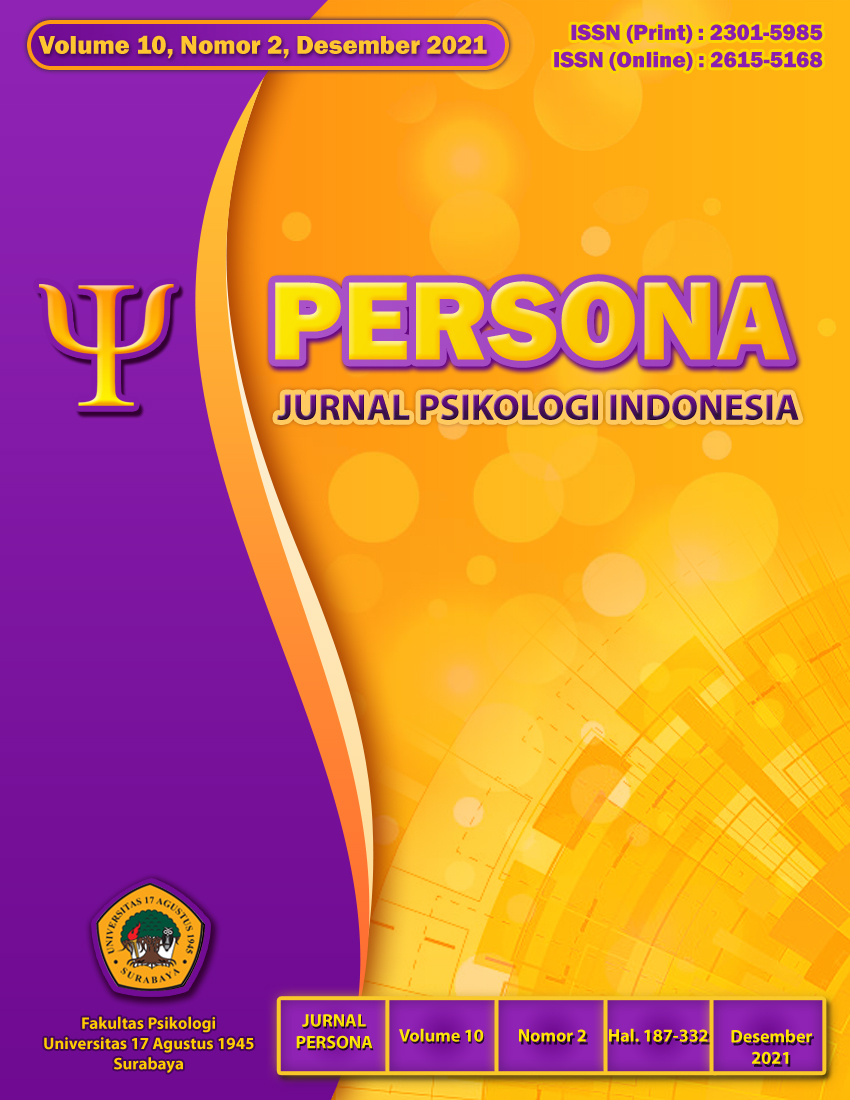Family communication patterns sebagai mediator antara empati dan konflik orang tua-anak pada remaja
DOI:
https://doi.org/10.30996/persona.v10i2.5351Keywords:
parent-child conflict, empathy, family communication pattern, adolescent, stay at homeAbstract
Abstract
The pandemic COVID-19 situation has made various activities changes, particularly with the implementation of the stay-at-home policy. One of the impacts is on the relationship between parents and children, such as the increased conflict between parents and children. In this research, we investigate how empathy in adolescents may give an impact conflict between parents and children frequency through family communication patterns. By using volunteer (opt-in) panels methods, a total of 566 adolescents (Mage = 17.21, SD = 1.82) completed questionnaire of Parental Environment Questionnaire (α = .86), Basic Empathy Scale (αaffective = .78, αcognitive = 0.75), and The Revised Family Communication Patterns (αconversation = .88, αconformity = 0.78) that has been translated into Bahasa Indonesia. The result showed that family communication patterns mediate the correlation between empathy in the adolescent with parent-child conflict. This research highlights the importance of empathy by having an open conversation among family members to reduce conflict between parent and child, particularly during the stay-at-home situation.
Keyword: Adolescent; empathy; family communication pattern; parent-child conflict; stay at home
Abstrak
Kondisi pandemi COVID-19 saat ini membuat berbagai aktifitas menjadi berubah terutama dengan diberlakukannya kebijakan stay at home. Salah satu dampak yang terjadi terkait dengan hubungan orang tua dan anak, seperti meningkatnya konflik antara orang tua dan anak. Penelitian ini bertujuan untuk mengetahui bagaimana pengaruh empati pada remaja dengan frekuensi konflik orang tua dan anak melalui family communication patterns yang diterapkan di dalam keluarga. Penelitian ini melibatkan 566 remaja (Musia = 17.21, SD = 1.82) yang dipilih menggunakan metode volunteer (opt-in) panels. Partisipan diminta mengisi kuesioner dengan alat ukur Parental Environment Questionnaire (α = .86), Basic Empathy Scale (αafektif = .78, αkognitif = 0.75), dan The Revised Family Communication Patterns (αconversation = .88, αconformity = 0.78) yang sudah diadaptasikan ke dalam Bahasa Indonesia.
Hasil penelitian menunjukkan bahwa family communication patterns dapat menjadi mediator dalam hubungan antara empati pada remaja dengan konflik orang tua-anak. Penelitian ini menyoroti pentingnya empati yang ditunjukkan melalui komunikasi terbuka antara anggota keluarga untuk menurunkan konflik anak dan orang tua, terutama pada masa stay at home.
Kata kunci: Empati; family communication patterns; konflik orang tua-anak; remaja; stay at home
Downloads
Downloads
Published
Issue
Section
License
The author who will publish the manuscript at Persona: Jurnal Psikologi Indonesia, agree to the following terms:
1. Authors retain copyright and grant the journal right of first publication with the work simultaneously licensed under a Creative Commons Attribution ShareAlike License that allows others to share the work with an acknowledgment of the work's authorship and initial publication in this journal.
2. Authors are able to enter into separate, additional contractual arrangements for the non-exclusive distribution of the journal's published version of the work (e.g., post it to an institutional repository or publish it in a book), with an acknowledgment of its initial publication in this journal.
3. Authors are permitted and encouraged to post their work online (e.g., in institutional repositories, pre-prints sites or on their website) prior to and during the submission process, as it can lead to productive exchanges, as well as earlier and greater dissemination of published work






